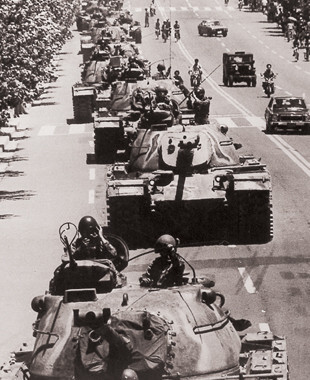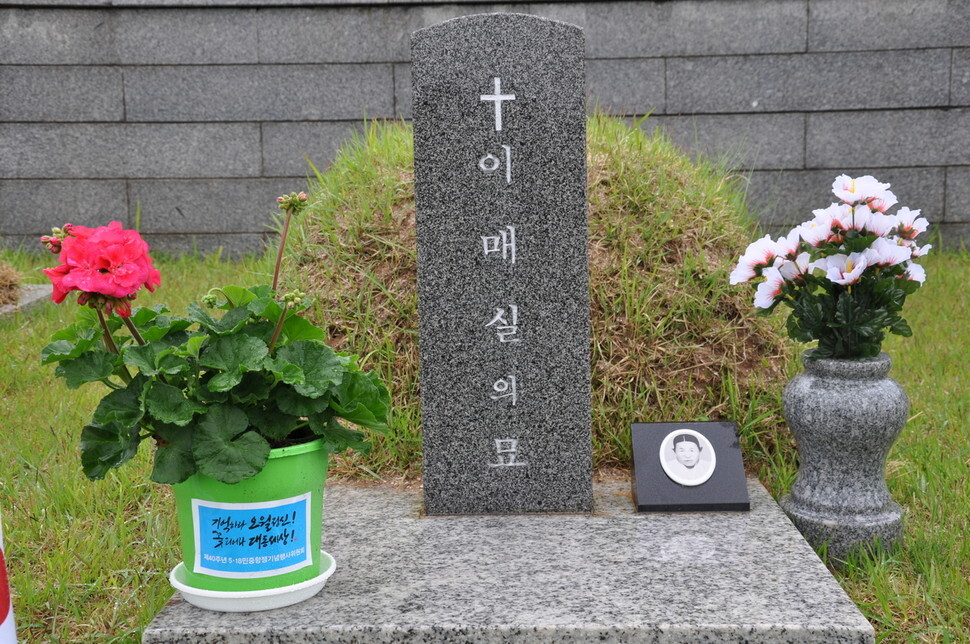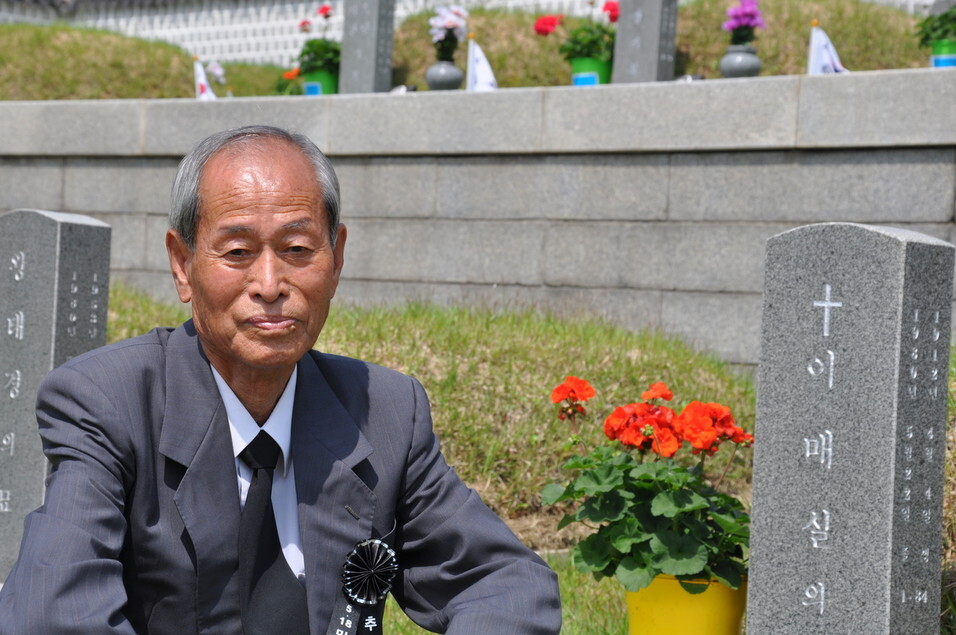hankyoreh
Links to other country sites 다른 나라 사이트 링크
[Interview] Testimonies of civilian slaughter during the Gwangju Democratization Movement

“Of course they ought to be punished. But what are powerless people like us supposed to do?”
Kim Ok-su, an 82-year-old resident of the village of Singok in Naju, South Jeolla Province, let out a sigh as he stood before the grave of his mother Lee Mae-sil in Gwangju’s May 18th National Cemetery on May 17, a day before the 40th anniversary of the May 19890 Gwangju Democratization Movement. Kim briefly left the hospital where he has been admitted with chronic illness to attend a commemorative ceremony that day for the anniversary.
Kim was a 42-year-old farmer at the time of the events of May 1980; his mother was 68. He asked his mother, who was living in their hometown, to look after his children, a first-year middle school student and a fifth graders in elementary school who were studying in Gwangju. Without a moment’s hesitation, she agreed to come to Gwangju and cook for her grandchildren.
At 5 pm on May 22, 1980, Lee was at home on the second floor of 1002-37 Ssangchon-dong in Gwangju’s Seo (West) District when she was struck in the head by bullets that pierced the door. Hit with multiple rounds, she died at the scene. She had not been anywhere near a demonstration.
After opening fire in front of the South Jeolla Provincial Office the day before, martial law forces retreated to the outskirts and began a blockade operation to ensure the Gwangju demonstrations did not spread outside the city. The 62nd Regiment of the 20th Division, which had been sent into Gwangju, received orders that day to secure the Gwangju Armed Forces Hospital. The martial law forces headed onto an eight-lane highway with tanks in front of them and began firing their rifles at buildings. For Lee, who had been living in the first house along the road about 200m from the hospital, death came like a bolt from the blue.
“I rushed over with a coffin on my motorbike, and they stopped me in front of the Sangmudae [Army Training and Doctrine Command],” Kim recalled. “I pleaded with them and showed them the coffin. I put her in the casket myself, and then I spent the night without sleeping before going to my hometown [Naju, South Jeolla Province] the next day on a vegetable truck. I buried her at the family gravesite, and about 10 days later, they told me to bring her body back for an autopsy. I had no choice but to dig her up. It brings tears to my eyes even now, thinking of how I dishonored her.”
The martial law forces reported that they had been “returning fire that had been coming from demonstrators in apartments and other tall buildings,” adding that they had recorded “three killed, 10 wounded, and 25 arrested.” But in 1995, prosecutors concluded that six residents aged 17 to 68 had been killed; members of May 1980 groups claimed that at least eight people lost their lives.
In terms of indictments by prosecutors alone, civilians killed by martial law forces during the events of May 1980 account for nine cases. The list includes massacres at Hyocheon Station on the outskirts of the cityu, the village of Junam, and Gwangju Detention Center. Prosecutors have identified victims, but the perpetrators have not been investigated on the grounds that they were “just following orders.” As a result, the precise circumstances and death toll have never been fully brought to light.

Numerous eyewitnesses have testified to the massacres of civilians. The “Junam incident” on the road near Junam reservoir, in which multiple people were slain on May 22-23 in a shooting attack on a minibus, was verified in a National Assembly hearing and investigation by prosecutors. Eyewitnesses also reported two other massacres that occurred at different times. At the Gwangju Detention Center -- a security institution -- evidence of violence by the state was rigorously covered up. The martial law forces’ shot at Kim Seong-su and his family while they were traveling on a national route and at four Damyang residents on a highway on May 21-22. Both attacks were falsely claimed as efforts to “fend off attacks by rebels.”

Former members of the martial law forces and prison guards also reported the secret burials of citizens who had been arrested at Chonnam National University and elsewhere, only to be killed when a tear gas grenade was set off in the vehicle and they were beaten with clubs while being transported to the detention center for incarceration. In the neighborhood of Songam on May 28, resident Gwon Geun-rip’s son and four of his friends were killed during searches of nearby homes after a skirmish among martial law forces resulted in fatalities. The fate of a young man surnamed Kim who was shot at close range with an M16 round to the temple by a non-commissioned officer with the 11th Special Forces Brigade remains unknown 40 years later. His family members witnessed the slaying, but his body has never been found.
The commission investigating the movement also plans to investigate six cases of civilian massacres that fell outside the scope of “suppressing demonstrations.” It currently plans to question the unit commander and troops on the ground at the time to hold them legally and socially responsible.
“The perpetrators of state violence still either deny that civilian massacres took place or claim that they were defensive actions,” said Cho Jin-tae, executive director of the May 18 Memorial Foundation.
“We need to gather eyewitnesses and evidence concerning the civilian massacres and compile them into a state report. After that, we need to establish judicial justice through accusations with prosecutors or the establishment of a special prosecutor,” he insisted.

If the commission does report cases of civilian massacre victims to prosecutors after its investigation, a debate could unfold over whether those responsible can be punished. Legal experts suggested that former President Chun Doo-hwan and other figures responsible for the massacres could be tried again despite the ban on double jeopardy. According to their position, this would be possible by applying the standard of “crimes against humanity” according to the International Criminal Court’s Rome Statute, which entered effect after being ratified by 60 countries in 2002.
The Rome Statute’s definition of “crimes against humanity” includes acts of murder, injury, rape, imprisonment and deportation committed by state institutions against civilians as “part of a widespread or systematic attack.” This international agreement states that for the sake of human dignity, crimes against humanity can be punished without the constraints that apply according to ordinary criminal law principles, including retroactivity, the statute of limitations, and double jeopardy.
“If additional civilian massacres are brought to light, that increases the likelihood of meeting the criteria for murder as a crime against humanity,” said Park Gyeong-gu, an associate researcher at the Korean Institute of Criminology who majored in international criminal law in Germany.
“If we hope to punish those responsible, we need to move beyond the emotional level and make careful preparations in terms of legal principles, including questions like whether retroactivity can be applied, whether there are statute of limitations issues, and whether people can be tried a second time.”
By Ahn Kwan-ok, Gwangju correspondent
Please direct comments or questions to [english@hani.co.kr]

Editorial・opinion
![[Editorial] Penalties for airing allegations against Korea’s first lady endanger free press [Editorial] Penalties for airing allegations against Korea’s first lady endanger free press](https://flexible.img.hani.co.kr/flexible/normal/500/300/imgdb/original/2024/0502/1817146398095106.jpg) [Editorial] Penalties for airing allegations against Korea’s first lady endanger free press
[Editorial] Penalties for airing allegations against Korea’s first lady endanger free press![[Editorial] Yoon must halt procurement of SM-3 interceptor missiles [Editorial] Yoon must halt procurement of SM-3 interceptor missiles](https://flexible.img.hani.co.kr/flexible/normal/500/300/imgdb/child/2024/0501/17145495551605_1717145495195344.jpg) [Editorial] Yoon must halt procurement of SM-3 interceptor missiles
[Editorial] Yoon must halt procurement of SM-3 interceptor missiles- [Guest essay] Maybe Korea’s rapid population decline is an opportunity, not a crisis
- [Column] Can Yoon steer diplomacy with Russia, China back on track?
- [Column] Season 2 of special prosecutor probe may be coming to Korea soon
- [Column] Park Geun-hye déjà vu in Yoon Suk-yeol
- [Editorial] New weight of N. Korea’s nuclear threats makes dialogue all the more urgent
- [Guest essay] The real reason Korea’s new right wants to dub Rhee a founding father
- [Column] ‘Choson’: Is it time we start referring to N. Korea in its own terms?
- [Editorial] Japan’s rewriting of history with Korea has gone too far
Most viewed articles
- 160% of young Koreans see no need to have kids after marriage
- 2Presidential office warns of veto in response to opposition passing special counsel probe act
- 3Hybe-Ador dispute shines light on pervasive issues behind K-pop’s tidy facade
- 4S. Korea “monitoring developments” after report of secret Chinese police station in Seoul
- 5Months and months of overdue wages are pushing migrant workers in Korea into debt
- 6OECD upgrades Korea’s growth forecast from 2.2% to 2.6%
- 7[Editorial] Penalties for airing allegations against Korea’s first lady endanger free press
- 8Inside the law for a special counsel probe over a Korean Marine’s death
- 9Japan says it’s not pressuring Naver to sell Line, but Korean insiders say otherwise
- 10S. Korea discusses participation in defense development with AUKUS alliance